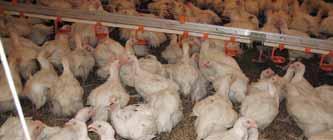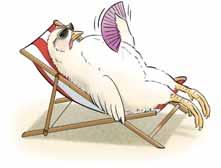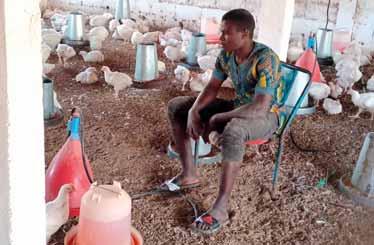
2 minute read
What the figures tell you
Heat stress
As the broilers get older their daily growth rate increases rapidly, as does their feed consumption. Only 25% of the energy they take in is used for movement, growth, breathing and body temperature maintenance (41°C core temperature). The other 75% is lost in the form of heat. But chickens can’t sweat. Their main way of getting rid of this excess heat is by evaporating moisture during respiration. High relative humidity very soon causes chickens problems: their airways have to work much harder to evaporate moisture into the air. During hot seasons use sodium bicarbonate (1 g/kg feed) and vitamin C (50 mg/kg feed) to reduce heat stress.
Advertisement
Panting: too hot, short of air, or forewarning of death?
When a broiler gets too hot, it will pant fast with its beak open. You can tell by the rapid up-and-down movement of its throat. At the same time it will often raise its feathers and hold its wings out slightly from its body, allowing its skin maximum contact with the circulating air to dissipate more heat. If the density of birds in the house is too high and the birds are pressed up against each other, they will struggle to do this. If they can lie with their chests on the ground they can expel heat quite easily through the thinner plumage and thinner fat layer on the chest. But if the litter is too hot they won’t be able to expel heat through the floor. A broiler’s environmental needs change during its life. At the beginning of the heat it needs has to be supplied. At the end of the production cycle the opposite is true: the house is full, the birds are bigger and they produce a lot of heat that they need to get rid of through ventilation. Sufficient ventilation is also necessary to get rid of CO2, moisture and NH3, and for the supply of fresh air, which becomes more important towards the end of the cycle. towards the he end of the cycle copyright protected

Heat stress and gut damage. Don’t feed broilers during the hottest part of the day. In order to get rid of the superfluous heat, more blood flows to the skin and less to the gut. If this lasts too long, gut damage can occur. Less feed in the gut means that less oxygen is needed for digestion and less heat is produced by the body. Getting used to the heat. G i d h h Broilers can B il ‘learn’ to tolerate higher temperatures. If the temperature increases very gradually, they can withstand temperatures of up to 38°C. In temperature fluctuations of more than 8°C per day, a broiler can’t adjust its body processes fast enough. The ability to adjust also depends on the genetic make-up of the chickens. Vitamin C against stress. Vitamin C is needed to produce certain stress hormones. Broilers are not yet able to produce enough vitamin C themselves and even less when suffering from heat stress. It is useful to add extra vitamin C to the drinking water in that case. Bicarbonate (HCO3) also helps.







